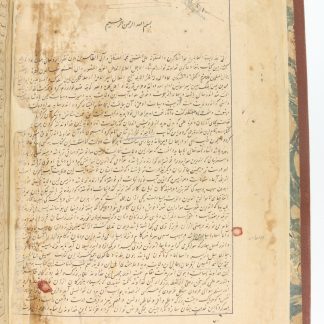Based on Ibn Sina's Qanun
Qanunceh ("Small Canon").
8vo (ca. 135 x 204 mm). Arabic manuscript on paper. 79 ff., written space ca. 75 x 150 mm, carefully ruled; 9 lines per extensum. Black ink with relevant words and headings marked in red. Written in careful naskh style, albeit slightly influenced by the thuluth pen. Colophon names the scribe as Abdallah al-Heravi. Near-contemporary brown calf binding.
Complete Arabic manuscript containing the Arabic translation of the Qanunsah ("Small Canon"), originally written in Persian: a brief medical compendium compiled by the Khwarazmian polymath Mahmud ibn Muhammad ibn Umar al-Jaghmini and based on Ibn Sina's famous Qanun.
This abridged manual of medicine is arranged in ten parts ("maqalat", or "discourses"), each of which contain several chapters. The first maqalat serves as a general introduction, dealing with the basic concepts of 14th century medical science and illustrating the various physical qualities (al-arkan) and body constitutions (al-amzigat), then focusing on the four Galenic humours (al-ahlat) - i.e. blood, phlegm, yellow and black bile - before discussing the parts of the body, the senses or faculties (al-quwá), and the preservation of one's natural temper (al-umur at-tabi iya). Further "discourses" treat anatomy, the various "conditions of the human body" ("ahwal badan al-insan"), the pulse, the "tafsira", or urine bottle given to the physician by the patient for inspection, the various aspects of the "wise management of diseases", "head diseases" and "diseases affecting the other body parts", chronic diseases of the various organs, evident defects (or "infirmities") in the external appearance of the body, fevers, and ultimately the importance of food and drink as remedies.
More frequently encountered in the original Persian than in Arabic translation, the Qanunceh was widely used at Eastern Persian schools as an introductory medical instruction manual for at least three centuries. Little is known about the scribe Abdallah al-Heravi, but at the time of copying this manuscript he must have been at an early stage of his career, as we have evidence of his activity at least until 1467 CE, fully 30 years after this manuscript was realized. This interesting 15th century handwritten booklet, professionally restored with several old remarginings, is generally in fine condition.






